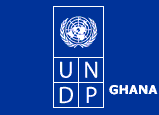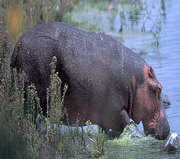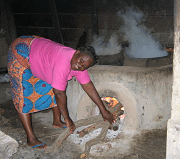|
|
|
|
|
United
Nations Development Programme |
Ghana |  |




|
UNDP Global Environmental Facility (GEF)/Small Grants Programme (SGP)-Ghana Biodiversity
Biodiversity Conservation and sustainable developmentThrough the GEF/SGP interventions in Ghana, the biological diversities of forests outside the gazetted reserves are being protected and conserved. To date about 200,000 ha of traditionally protected community forests have been conserved and new community natural resource management areas have been created and sustainably conserved. Several endangered species have been conserved and potential risks to human development and aspiration due to climate change induced by greenhouse gas emissions have been mitigated. The livelihoods of several thousands of people have been supported through alternative livelihood activities. Rural capital assets and wealth have been created and redistributed to benefit the poor and marginalized/disadvantaged in society. A new rural enterprise based on biodiversity conservation and utilization is emerging. The beneficial impact in the GEF focal areas comes about through using sustainable livelihood strategies. The sustainable livelihood perspective posits that communities will more readily design and participate in SGP interventions if their economic and other interests are taken into consideration. Thus, an essential part of the SGP projects has often been an income-generation component linked to one of the GEF focal areas. Moreover, communities must be given viable alternatives to economic and cultural practices that may endanger biodiversity, contribute to climate change, or degrade international freshwater or marine systems.
The GEF/SGP in Ghana has distinguished itself in assisting local communities to conserve biological diversities of forests outside the gazetted forest reserves. The methodology has been to assist the communities to create buffer zone around the sacred groves, rehabilitate degraded areas through enrichment planting and natural regeneration. The concept of Community Resource Management Area (CREMA) is then introduced
for the communities to manage flora and fauna within the community lands.
This is done through effective revision and enforcement of traditional
laws on natural resource management. Alternative livelihoods are introduced
first to help conserve the biodiversity and also to minimize the negative
effects of the project intervention on “losers” and those
who are likely to undermine the sustainability of the project benefits. The GEF/SGP is supporting Wildlife Division of the Forestry Commission to implement the CREMA concept by assisting communities to manage wildlife and other natural resources in their own forests. The CREMA concept intends to devolve management authority of wildlife and other natural resources to community based organizations. In most of the projects, Wildlife management is given a focused value in resource management and the resource owners are being empowered to control access to and harvesting of wildlife in their area of jurisdiction by outsiders. The incentive in the CREMA approach is both financial (through the sale of wild products in the market and tenurial through control of access to the area). By the programme approach, various geographic areas of forests and savannah resources are being defined for community management. Institutionally, community based organizations are being formed and strengthened to utilize indigenous knowledge in resource management. It is also empowering the communities to have collective decisions, rules and regulations to govern “common” resources which hitherto were no mans responsibility. To date over 200,000 ha of traditionally protected community forests
have been surveyed, demarcated and conserved with traditional norms as
CREMA and wildlife sanctuaries. About 10 new CREMA with an average size
of 100 km2 have been created, surveyed and mapped. Formulation of participatory
landuse plans and community agreements are far advanced for most of the
communities. Management of both flora and fauna in these areas are guided
by traditional norms and efforts are being made to obtain formal certificates
which transfer authority for the management of the area. Several rare and endangered species have been spotted in some of the
community protected land under SGP projects. A recent flora and fauna
inventory of four of the SGP Sacred Groves and CREMA in the forest and
savannah areas revealed that some rare, endangered and uncommon species
in the country have been conserved and potential risks to human development
and aspiration due to climate change induced by greenhouse gas emissions
have been mitigated. Table 3 shows some of the rare species that are being
protected and conserved in SGP project areas. Ecotourism Promotion
|
Global GEF and Global SGP GEF Operational Programmes Ghana GEF SGP Thematic Areas Project Overview current projects Biodiversity Climate Change Project Tracking System Geographic Information System Network of Partners Environmental NGOs GEF Ghana Staff Eligibility for Grants/Application FAQs Contacts Copyright & Terms of Use Current News |
||
| Copyright © United Nations Development Programme-Ghana/GEF-SGP, 2004. All rights reserved. |